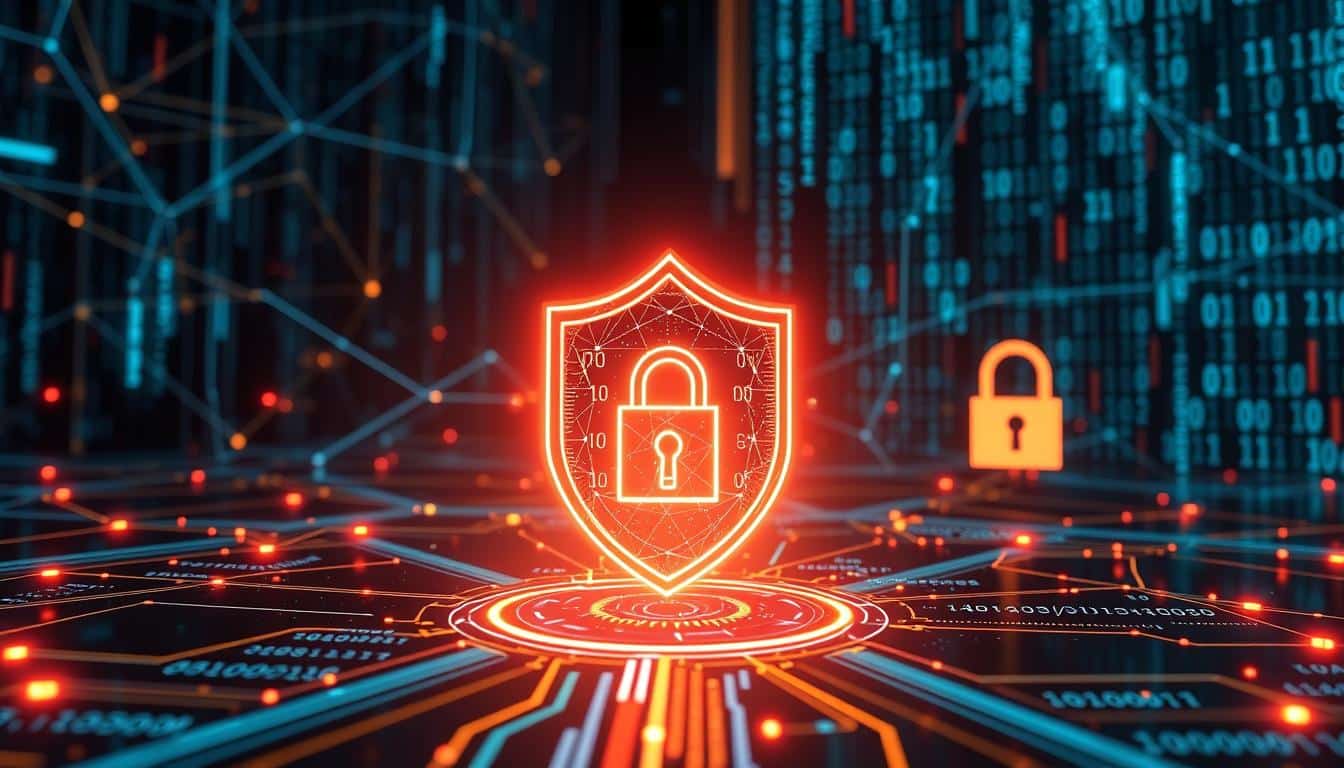In today’s digital world, all businesses must focus on cybersecurity. A security breach can damage a company’s finances, reputation, and customer trust. This makes a strong cybersecurity strategy crucial for staying competitive and keeping business running smoothly.
Effective strategies include using multi-factor authentication, regular testing, and planning for incidents. These steps help protect against advanced cyber threats and keep digital assets safe.
Businesses need to be proactive about cybersecurity. It’s not just for the IT team. Everyone in the company should learn how to spot and stop threats. Leaders must also get involved and include cyber risk in their plans.
Key Takeaways
- Businesses must integrate comprehensive cybersecurity measures into their overall business strategy to protect against sophisticated cyber threats and safeguard digital assets.
- Effective cybersecurity strategies include multi-factor authentication, regular penetration testing, and incident response planning to maintain a competitive edge and ensure business continuity.
- Cybersecurity must be a company-wide commitment, with employee training and awareness being crucial components of an effective strategy.
- Strong leadership involvement and the incorporation of cyber risk assessment into strategic planning are key to developing and implementing a successful cybersecurity strategy.
- Businesses must take a proactive approach to cybersecurity, recognizing it as an essential part of their overall business strategy.
The Importance of Integrating Cybersecurity into Business Strategy
In today’s digital world, cybersecurity is key to a business’s success. It’s vital to add security to the heart of a company’s plans. This helps keep the business running smoothly and protects its good name. Phishing, a common cybercrime, is growing, and one data breach can harm finances and reputation greatly.
Business Continuity and Reputation Management
A strong cybersecurity plan is essential for keeping a business going. DTEX found a 35% jump in data theft by employees leaving in 2022. Weak passwords led to big breaches, like the 2018 North Ireland Parliament hack. Companies must focus on a solid risk management plan to fight these threats and keep running during tough times.
Protecting Customer Data and Sensitive Information
Keeping customer data safe is a big part of a business’s cybersecurity strategy. A data breach can hurt customer trust and lead to expensive legal issues. Businesses use cybersecurity experts and follow best practices like security checks and data protection policies to keep customer info safe.
Cybersecurity is a must for businesses to build trust with customers, partners, and investors. It stops cyberattacks and handles them well when they happen. By focusing on security, companies can stay strong, protect their assets, and stay ahead in the market.
Essential Components of an Effective Cybersecurity Strategy

Creating a solid cybersecurity strategy is key for businesses to fight off cyber threats. The National Institute of Standards and Technology (NIST) says there are five main parts to a good cybersecurity plan:
-
Multi-Factor Authentication and Access Controls
Using strong multi-factor authentication and access controls is a must. It helps protect important data and keeps it safe from unauthorized access. By checking user identities in different ways, companies can lower the chance of data breaches.
-
Regular Penetration Testing and Risk Management
Doing regular penetration tests and managing risks well is vital. It helps find and fix security weaknesses. This keeps companies ahead of cyber threats and makes their security stronger.
-
Incident Response Planning
A good incident response plan is key to keep business running after a security breach. It should have clear steps for finding, handling, and fixing cyber incidents. This helps keep operations and reputation safe.
By adding these key parts to their cybersecurity plan, companies can boost their security. They can also lower the risk of cyber attacks. This helps keep their data and assets safe.
| Key Cybersecurity Metrics | Industry Benchmarks |
|---|---|
| Security Incidents Detected | 50-100 per month (average) |
| Incident Response Time | 4-8 hours (target) |
| Penetration Test Findings | 10-20 vulnerabilities (average) |
| Employee Cybersecurity Training Completion | 95-100% (goal) |
By following industry best practices and frameworks like NIST, companies can better handle cyber risks. This makes their security stronger overall.
“Cybersecurity is not just an IT problem; it’s a business risk that requires a strategic, company-wide approach.”
Cybersecurity as a Company-Wide Commitment

Cybersecurity is not just for the IT team. It’s a priority for the whole company. To build a security-aware culture, training and awareness programs are key. They help prevent data breaches and protect customer and sensitive data.
Employee Training and Awareness
Training employees helps them spot and report threats like phishing. A Pluralsight study found 40% of tech leaders see cybersecurity as crucial. By talking about risks in terms each department understands, companies can build a security-focused team.
- Build a culture where everyone thinks about security, no matter their job.
- Get each department on board by showing how cybersecurity affects them.
- Encourage teamwork by letting employees share security concerns and ideas.
- Use games to make training fun and keep employees interested and informed.
A solid cybersecurity plan needs constant checks, security steps, and following industry rules like PCI DSS. With support from leaders and a culture focused on security, companies can fight off cyber threats and keep their important assets safe.
Mitigating the Risk of Data Breaches

Protecting against data breaches is key to a strong cybersecurity strategy. Businesses need to know about common cyber attack methods and weaknesses that can cause big data breaches. Phishing, malware, and insider threats are big risks. Weak passwords, outdated software, and bad network setups are also big problems.
To fight these risks, regular security checks and strong security steps are vital. Using endpoint security, security monitoring, and security management tools helps spot and fix threats early. The National Institute of Standards and Technology (NIST) offers great advice on cybersecurity strategies. These are important for all businesses, big or small.
Addressing Common Cyber Attack Methods and Vulnerabilities
Organizations must know about common cyber attack methods and security vulnerabilities to protect their security information and security capabilities. By doing regular security checks and being quick to act, businesses can fight threats and get stronger.
- Phishing attacks are a big threat that targets people or companies with fake emails.
- Malware can get into systems and networks, stealing data and messing with systems.
- Insider threats, like unhappy employees, can be a big risk to security management and security monitoring.
- Weak passwords, unpatched software, and insecure network setups are easy targets for hackers.
| Cyber Attack Method | Potential Impact | Mitigating Strategies |
|---|---|---|
| Phishing | Compromise of user credentials, malware distribution | Employee training, multi-factor authentication, email filtering |
| Malware | Data theft, system disruption, financial loss | Endpoint protection, regular software updates, backup and recovery |
| Insider Threats | Data leaks, sabotage, financial fraud | Access controls, employee monitoring, incident response planning |
By having a solid cybersecurity strategy that tackles these common cyber attack methods and security vulnerabilities, companies can lower the risk of expensive and harmful data breaches.
Leadership Involvement and Governance
For a strong organization’s cybersecurity strategy, leadership is key. Top executives must lead in security efforts. They should report risks, stay updated on threats, and protect digital assets.
Incorporating Cyber Risk Assessment into Strategic Plans
Businesses need to include a detailed cybersecurity risk assessment in their plans. This helps identify important assets, threats, and weaknesses. It also makes sure security solutions fit with the business goals.
The Cybersecurity and Infrastructure Security Agency (CISA) is vital for Federal Civilian Executive Branch (FCEB) Agencies. CISA sets security standards, boosts cybersecurity and incident response, and protects critical networks.
CISA’s Binding Operational Directives (BODs) and Emergency Directives (EDs) help fix vulnerabilities. They improve asset visibility and reduce known exploited vulnerabilities on federal networks. These are important for the civilian Executive Branch.
CISA also works with the National Association of State Chief Information Officers (NASCIO) on cybersecurity governance. They’ve created a State Cybersecurity Governance Report and case studies. These show the value of teamwork in building strong security infrastructure and security teams.
By adding cybersecurity risk assessment to plans and having strong leadership, organizations can create a solid security strategy. This strategy meets the organization’s needs and supports its goals.
Cybersecurity Strategies
Businesses face a changing cybersecurity world and must act proactively to protect their digital assets. Regular security checks and scans are key. They find weak spots in security, helping teams fix them before cyber threats can attack.
Securing the Endpoints and the Cloud
Businesses also need strong endpoint and cloud security. This means using multi-factor authentication, encryption, and more. These steps add layers of defense against cyber attacks. Securing these areas greatly lowers the risk of data breaches and unauthorized access.
Mitigating Third-Party Risks and Data Loss
Today, third-party vendors can pose big security risks. To tackle this, businesses must manage third-party risks well. They should check and watch their partners’ security closely. Also, using data loss prevention helps keep sensitive info safe and ensures business keeps running if a security issue arises.
By using these strategies, companies can better protect themselves. Regular security checks, strong endpoint and cloud security, and good third-party risk management are crucial. They help businesses deal with the digital world’s challenges and keep their data safe.
| Cybersecurity Strategy | Key Benefits |
|---|---|
| Regular Security Assessments and Vulnerability Scans | Identify and address security vulnerabilities before they can be exploited |
| Endpoint Protection and Cloud Security | Implement multi-factor authentication, encryption, and other advanced security controls to secure digital assets |
| Third-Party Risk Management and Data Loss Prevention | Mitigate risks posed by third-party vendors and safeguard sensitive information |
“Cybersecurity is not just an IT problem; it’s a business problem that requires a comprehensive, company-wide approach.”
Developing a comprehensive cybersecurity strategy is crucial for organizations to effectively address cyber threats and enhance their security posture. This process involves conducting a thorough risk assessment to identify potential risks and developing a risk management plan that incorporates best practices and effective cybersecurity strategies. Implementing a cybersecurity strategy requires the establishment of robust security policies and controls to mitigate the impact of cyber attacks and security incidents. Organizations should prioritize security awareness among employees and ensure that their cybersecurity program aligns with the NIST cybersecurity framework, which outlines necessary security requirements and best practices. Regular security assessments and a well-defined incident response plan are essential for managing security issues and enhancing cybersecurity maturity. By adopting effective security measures and utilizing the latest cybersecurity solutions, businesses can safeguard their data security and bolster their cybersecurity capabilities. This strategy also aligns with broader business strategies, ensuring that cybersecurity remains a key component of the overall management plan while addressing the evolving landscape of cybersecurity threats and maintaining a proactive approach to security.
Developing a comprehensive cybersecurity strategy is essential for any organization looking to navigate the current cyber threat landscape effectively. This strategy should include a robust risk management plan that assesses security risks and identifies the specific security needs of your business. Engaging cybersecurity professionals can help in implementing managed security solutions and conducting regular security audits and cybersecurity assessments. By adopting data security policies and security best practices, organizations can bolster their security infrastructure against prevalent security threats. The cybersecurity strategy is an ongoing process that requires agility in security measures to adapt to evolving cyber threats and security technologies. This involves conducting an assessment of your security capabilities and aligning them with the payment card industry data security standards. For small and medium businesses, establishing a strong cybersecurity framework is vital for mitigating security risks and ensuring compliance. Security teams must focus on various types of security, including endpoint security and security monitoring, to safeguard sensitive information. Involvement with the National Institute of Standards and Technology can also enhance your organization’s cybersecurity maturity by providing guidance on security management. Overall, a proactive approach to security efforts, leveraging appropriate security tools, and understanding common cyber threats are critical to achieving a resilient cybersecurity posture.
Also Read : What Are The Environmental Impacts Of Blockchain Innovation?
Conclusion
Protecting digital assets is key for businesses. They need a strong cybersecurity strategy to keep their data safe. This helps them stay in business and keep their good name.
Businesses must take steps to protect themselves. They should create a culture that values security. Leaders must also show they care about keeping data safe.
A good cybersecurity plan is vital for any business. It helps them deal with new threats and stay ahead in the market. They need to check their security often, protect their devices well, and manage risks from other companies.
Businesses must see cybersecurity as a top priority. They should make it part of their overall goals. This way, they can stay strong, protect their important data, and earn trust from their customers and partners.
FAQs
Q: What is a comprehensive cybersecurity strategy?
A: A comprehensive cybersecurity strategy is a plan that encompasses all aspects of cyber security, including the identification of security threats, implementation of security measures, and development of security policies to protect sensitive data and maintain a strong security posture for your business.
Q: How do I develop a cybersecurity strategy for my business?
A: To develop a cybersecurity strategy for your business, start with a cyber security assessment to identify vulnerabilities, establish security goals, and align your strategy with best practices. Then, implement security measures and create a cybersecurity program that includes training for cybersecurity teams and regular security audits.
Q: What are some cybersecurity best practices for businesses?
A: Cybersecurity best practices include implementing strong password policies, conducting regular security audits, training employees on security awareness, maintaining updated software, and creating incident response plans to handle potential security threats effectively.
Q: What is the importance of a cybersecurity program?
A: A cybersecurity program is essential for maintaining data security and protecting against cyber threats. It establishes a structured approach to identifying, protecting, detecting, responding to, and recovering from cybersecurity incidents, thereby enhancing the overall security posture of your organization.
Q: How can I assess my current cybersecurity maturity?
A: You can assess your cybersecurity maturity by conducting a cyber security assessment that evaluates your current security measures, identifies gaps in your security framework, and benchmarks your practices against industry standards and regulations.
Q: What role do cybersecurity professionals play in a business’s security strategy?
A: Cybersecurity professionals play a critical role in developing and implementing a cybersecurity strategy. They analyze the cyber threat landscape, monitor for security threats, create security policies, and ensure that security measures are effectively integrated into the business’s operations.
Q: How often should a business conduct security audits?
A: A business should conduct security audits at least annually, or more frequently if there are significant changes to the cyber threat landscape or the business’s operations. Regular audits help ensure compliance with security policies and identify areas for improvement in the cybersecurity program.
Q: What is the significance of security awareness training in a cybersecurity strategy?
A: Security awareness training is significant because it educates employees about potential cyber threats, promotes best practices for data security, and fosters a culture of security within the organization. This training helps reduce the risk of human error, which is a common factor in many security breaches.
Q: What are the main components of an effective cybersecurity plan?
A: An effective cybersecurity plan includes risk assessment, security policies, incident response procedures, employee training, regular security audits, and continuous monitoring of the cyber threat landscape to adapt to emerging threats and vulnerabilities.


